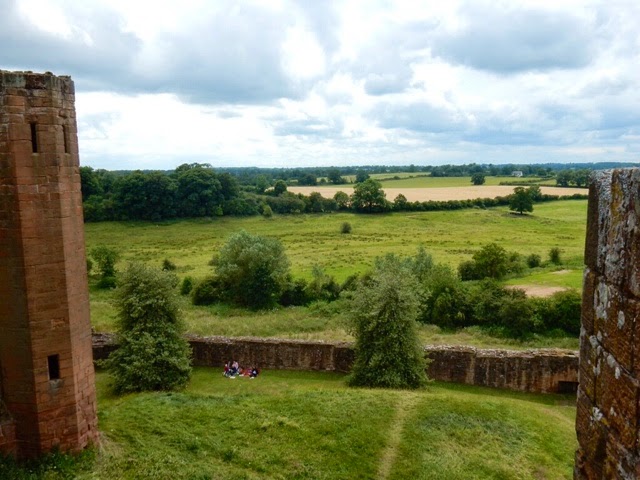Begun by Henry I in 1120, Kenilworth Castle became one of the most important castles in England.
Kenilworth Castle’s keep:

King John (the antagonist in the “Robin Hood” story, and the king who signed the Magna Carta) significantly strengthened the defenses and flooded the surrounding countryside to make one of the largest man-made water defenses in Europe. The castle, so strengthened, held out for six months against a siege by John’s son, Henry III, in 1266; this is believed to be the longest siege in English history.
The view from one of the towers across the outer wall. The countryside beyond the wall was completely flooded into a great lake to prevent attackers from undermining the wall:

- It was here in Kenilworth Castle that Edward II was forced to abdicate in 1327.
- It was in here in Kenilworth Castle that King Henry V received the famous “tennis balls” insult from the French King in 1414, which launched an English invasion of France and resulted in France almost completely being conquered by England. (Spoiler alert: Joan of Arc comes along and saves the day.)
In the 16th century, Robert Dudley, 1st Earl of Leicester, lavished a fortune on the castle to convert it into a palace fit for a queen, and it became one of Queen Elizabeth’s favorite places to visit. Sir Walter Scott wrote a novel about this period called Kenilworth. It appears that Leicester was hoping to marry Elizabeth. There is also a Tudor garden, originally built by Leicester for Elizabeth, if you’re into that sort of thing. I am not, and your kids might not be either, but if you are, at least your kids can explore on their own (our rule is that they can explore on their own, but they have to stay together) rather than annoying you with their boredom while you walk the gardens.
Even into the 17th century, Kenilworth Castle was formidable enough that Parliamentary forces slighted the keep to prevent it from being used as a Royalist stronghold.
This wall of the keep was pulled down by Roundheads during the English Civil War. It is notable because the cross-section shows just how thick the walls of the keep were:

While most of the castle crumbled to ruins around it, the gatehouse at least remained inhabited well into the 20th century.
We almost skipped Kenilworth, but since it was on our path from Broadway to Richmond, decided to stop in. We are glad we did. The kids spent hours wandering around and playing in the ruins. Like Hailes Abbey and Stonehenge, an audio guide is available so each member of your family can proceed around the castle at his or her own pace. It is English Heritage, so admission is free to members. There are vast lawns and picnic tables if you bring your lunch, or you can order from the café inside the walls.
I recommend Kenilworth Castle for any families visiting England. You can easily spend a few hours walking the grounds and the ruins, and it is safe enough (it is walled, after all) for your kids to explore on their own.
No comments:
Post a Comment